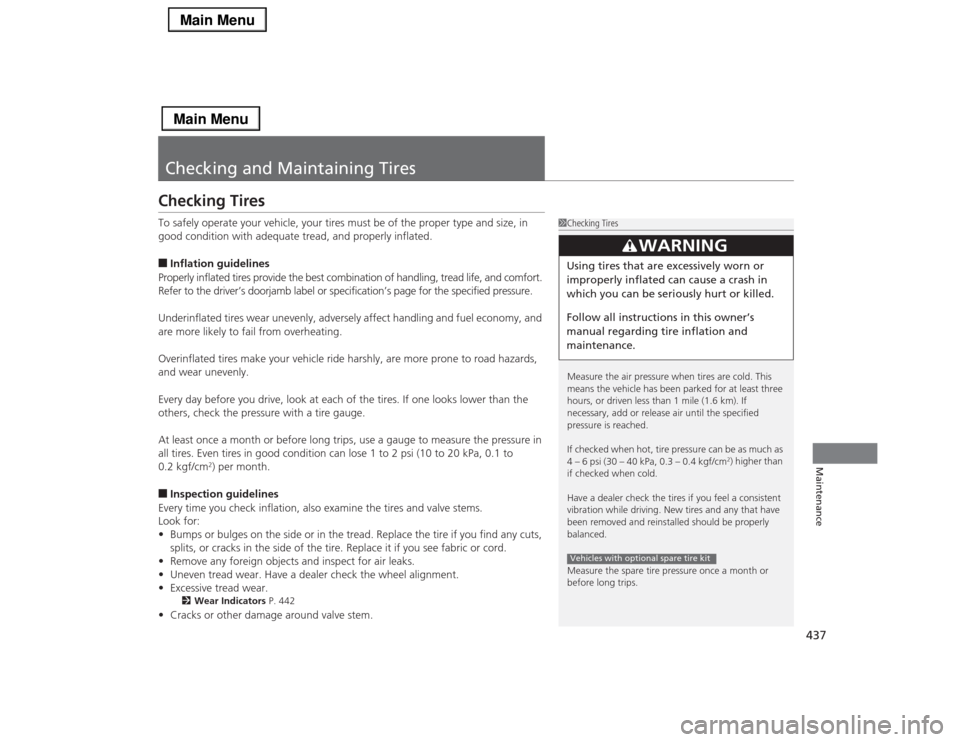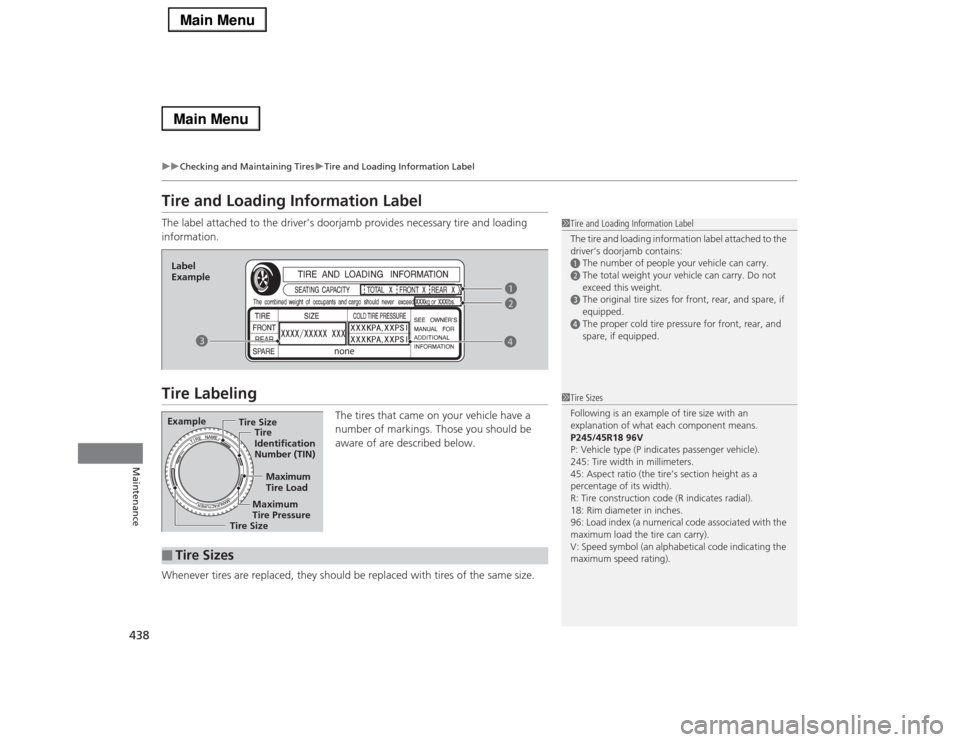Acura RLX 2014 Owner's Manual
Manufacturer: ACURA, Model Year: 2014, Model line: RLX, Model: Acura RLX 2014Pages: 518, PDF Size: 15.83 MB
Page 431 of 518

430
uuReplacing Light BulbsuFront Side Marker Light Bulbs
Maintenance
Front Side Marker Light BulbsWhen replacing, use the following bulbs.
1.Turn the steering wheel all the way to the
opposite side from the light being replaced.
Passenger’s side: Turn the steering wheel
to the left.
Driver’s side: Turn the steering wheel to
the right.
2.Remove the holding clips (A) and (B), pull
the inner fender back.
3.Turn the socket to the left and remove it,
then remove the old bulb.
4.Insert a new bulb.Side Turn Signal/Emergency Indicator Light BulbsDoor mirrors have the side turn lights. Have an authorized Acura dealer inspect and
replace the light assembly.Front Side Marker Light: 3 CP
1Front Side Marker Light Bulbs
When removing the clip, insert a flat-tip screwdriver,
then lift and remove the clip.
Insert the clip with the pin raised, and push until it is
flat.Holding clip (B-type)Clip
Push until the
pin is flat.
Inner Fender
Clip (A)
Clips (B)
Bulb
Socket
Page 432 of 518

431
uuReplacing Light BulbsuRear Turn Signal Light Bulbs
Maintenance
Rear Turn Signal Light BulbsWhen replacing, use the following bulbs.
1.Remove the cover.
2.Turn the socket to the left and remove it,
then remove the old bulb.
3.Insert a new bulb.Brake/Taillight and Rear Side Marker Light BulbsBrake/taillight and rear side marker light bulbs are LED type. Have an authorized
Acura dealer inspect and replace the light assembly.Rear Turn Signal Light: 21 W
Cover
BulbSocket
Page 433 of 518

432
uuReplacing Light BulbsuTaillight Bulbs
Maintenance
Taillight BulbsTaillight bulbs are LED type. Have an authorized Acura dealer inspect and replace the
light assembly.Back-Up Light BulbsWhen replacing, use the following bulbs.
1.Remove the cover.
2.Turn the socket to the left and remove it,
then remove the old bulb.
3.Insert a new bulb.Back-Up Light: 16 W
Cover
SocketBulb
Page 434 of 518

433
uuReplacing Light BulbsuRear License Plate Light Bulbs
Maintenance
Rear License Plate Light BulbsRear license plate light bulbs are LED type. Have an authorized Acura dealer inspect
and replace the light assembly.High-Mount Brake Light BulbsHigh-mount brake light bulbs are LED type. Have an authorized Acura dealer inspect
and replace the light assembly.Door Outer Handle Ambient Light BulbsDoor outer handle ambient light bulbs are LED type. Have an authorized Acura
dealer inspect and replace the light assembly.
Page 435 of 518

434Maintenance
Checking and Maintaining Wiper BladesChecking Wiper BladesIf the wiper blade rubber has deteriorated, it will leave streaks and the metal wiper
arm may scratch the window glass.Changing the Wiper Blade Rubber
1.Set the power mode to VEHICLE OFF
(LOCK).
2.While holding the wiper switch in the
MIST position, set the power mode to ON,
then to VEHICLE OFF (LOCK).
uBoth wiper arms are set to the
maintenance position as shown in the
image.
3.Lift both wiper arms.
1Changing the Wiper Blade RubberNOTICEAvoid dropping the wiper arm; it may damage the
windshield.
Page 436 of 518

435
uuChecking and Maintaining Wiper BladesuChanging the Wiper Blade Rubber
Continued
Maintenance
4.Press and hold the tab, then slide the
blade out from the wiper arm.
5.Pull the end of the wiper blade to the
direction of the arrow in the image until it
unfastens from the holder’s end cap.
6.Pull the wiper blade to the opposite
direction to slide it out from its holder.
Tab
Wiper
Blade
End Cap at
the bottomHolder
Page 437 of 518

436
uuChecking and Maintaining Wiper BladesuChanging the Wiper Blade Rubber
Maintenance
7.Insert the flat side of the new wiper blade
onto the bottom part of the holder. Insert
the blade all the way.
8.Install the end of the wiper blade into the
cap.
9.Slide the wiper blade onto the wiper arm
until it locks.
10.Lower both wiper arms.
11.Set the power mode to ON and hold the
wiper switch in the MIST position until
both wiper arms return to the standard
position.
CapWiper
Blade
Holder
Page 438 of 518

437Maintenance
Checking and Maintaining TiresChecking TiresTo safely operate your vehicle, your tires must be of the proper type and size, in
good condition with adequate tread, and properly inflated.■Inflation guidelines
Properly inflated tires provide the best combination of handling, tread life, and comfort.
Refer to the driver’s doorjamb label or specification’s page for the specified pressure.
Underinflated tires wear unevenly, adversely affect handling and fuel economy, and
are more likely to fail from overheating.
Overinflated tires make your vehicle ride harshly, are more prone to road hazards,
and wear unevenly.
Every day before you drive, look at each of the tires. If one looks lower than the
others, check the pressure with a tire gauge.
At least once a month or before long trips, use a gauge to measure the pressure in
all tires. Even tires in good condition can lose 1 to 2 psi (10 to 20 kPa, 0.1 to
0.2 kgf/cm
2) per month.
■Inspection guidelines
Every time you check inflation, also examine the tires and valve stems.
Look for:
•Bumps or bulges on the side or in the tread. Replace the tire if you find any cuts,
splits, or cracks in the side of the tire. Replace it if you see fabric or cord.
•Remove any foreign objects and inspect for air leaks.
•Uneven tread wear. Have a dealer check the wheel alignment.
•Excessive tread wear.2Wear Indicators P. 442
•Cracks or other damage around valve stem.
1Checking Tires
Measure the air pressure when tires are cold. This
means the vehicle has been parked for at least three
hours, or driven less than 1 mile (1.6 km). If
necessary, add or release air until the specified
pressure is reached.
If checked when hot, tire pressure can be as much as
4 – 6 psi (30 – 40 kPa, 0.3 – 0.4 kgf/cm
2) higher than
if checked when cold.
Have a dealer check the tires if you feel a consistent
vibration while driving. New tires and any that have
been removed and reinstalled should be properly
balanced.
Measure the spare tire pressure once a month or
before long trips.
3
WARNING
Using tires that are excessively worn or
improperly inflated can cause a crash in
which you can be seriously hurt or killed.
Follow all instructions in this owner’s
manual regarding tire inflation and
maintenance.Vehicles with optional spare tire kit
Page 439 of 518

438
uuChecking and Maintaining TiresuTire and Loading Information Label
Maintenance
Tire and Loading Information LabelThe label attached to the driver’s doorjamb provides necessary tire and loading
information.Tire Labeling
The tires that came on your vehicle have a
number of markings. Those you should be
aware of are described below.
Whenever tires are replaced, they should be replaced with tires of the same size.
1Tire and Loading Information Label
The tire and loading information label attached to the
driver’s doorjamb contains:aThe number of people your vehicle can carry.bThe total weight your vehicle can carry. Do not
exceed this weight.cThe original tire sizes for front, rear, and spare, if
equipped.dThe proper cold tire pressure for front, rear, and
spare, if equipped.
a
Label
Example
b
c
dExample
Tire Size
Tire
Identification
Number (TIN)
Maximum
Tire Load
Maximum
Tire Pressure
Tire Size■
Tire Sizes
1Tire Sizes
Following is an example of tire size with an
explanation of what each component means.
P245/45R18 96V
P: Vehicle type (P indicates passenger vehicle).
245: Tire width in millimeters.
45: Aspect ratio (the tire’s section height as a
percentage of its width).
R: Tire construction code (R indicates radial).
18: Rim diameter in inches.
96: Load index (a numerical code associated with the
maximum load the tire can carry).
V: Speed symbol (an alphabetical code indicating the
maximum speed rating).
Page 440 of 518

439
uuChecking and Maintaining TiresuTire Labeling
Maintenance
The tire identification number (TIN) is a group of numbers and letters that look like
the example in the side column. TIN is located on the sidewall of the tire.
Cold Tire Pressure – The tire air pressure when the vehicle has been parked for at
least three hours or driven less than 1 mile (1.6 km).
Load Rating – Means the maximum load that a tire is rated to carry for a given
inflation pressure.
Maximum Inflation Pressure – The maximum tire air pressure that the tire can
hold.
Maximum Load Rating – Means the load rating for a tire at the maximum
permissible inflation pressure for that tire.
Recommended Inflation Pressure – The cold tire inflation pressure recommended
by the manufacturer.
Treadwear Indicators (TWI) – Means the projections within the principal grooves
designed to give a visual indication of the degrees of wear of the tread.■
Tire Identification Number (TIN)
■
Glossary of Tire Terminology
1Tire Identification Number (TIN)DOT B97R FW6X 2209
DOT: This indicates that the tire meets all
requirements of the U.S. Department of
Transportation.
B97R: Manufacturer’s identification mark.
FW6X: Tire type code.
22 09: Date of manufacture.
Year
Week